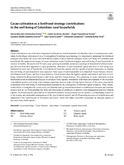Mostrar el registro sencillo del ítem
Cacao cultivation as a livelihood strategy: contributions to the well‑being of Colombian rural households
| dc.contributor.author | Hernámdez-Núñez, Héctor Eduardo | |
| dc.contributor.author | Gutiérrez-Montes, Isabel | |
| dc.contributor.author | Bernal-Núñez, Angie Paola | |
| dc.contributor.author | Gutiérrez-García, Gustavo Adolfo | |
| dc.contributor.author | Suárez, Juan Carlos | |
| dc.contributor.author | Casanoves, Fernando | |
| dc.contributor.author | Butler Flora, Cornelia | |
| dc.date.accessioned | 2021-07-13T20:55:53Z | |
| dc.date.available | 2021-07-13T20:55:53Z | |
| dc.date.issued | 2021-07 | |
| dc.identifier.uri | https://doi.org/10.1007/s10460-021-10240-y | |
| dc.identifier.uri | https://repositorio.catie.ac.cr/handle/11554/11054 | |
| dc.description.abstract | Cacao cultivation is one of the most important livelihoods for rural households in Colombia, where it is promoted as a substitute for the illegal cultivation of coca. To strengthen Colombian cacao farming, it is important to understand the livelihood strategies associated with cacao cultivation and the impact of these different strategies on the well-being of Colombian rural households. We analyzed the impact of cacao cultivation on the livelihood strategies and well-being of rural households in western Colombia. Research with 92 rural cacao-growing households produced a typology of household livelihood strategies derived from their approach to cacao production. Indicators of each household capital and level of well-being were identified for each type of households. Correlations between the capitals and the capitals of greater importance in shaping the well-being of rural households were analyzed. Three types of rural households were identified: Cacao Farmers, Diversified Farmers with Cacao, and New Cacao Farmers. Cacao farmers have the highest capitals endowments and level of wellbeing, followed by Diversified Farmers with Cacao, and New Cacao Farmers. The conditions of cacao cultivation in rural households result in differentiated access to resources from capitals; households with better development of the crop have consolidated greater well-being where human capital has been its major driving factor. Success of the cacao crop and its relationship with well-being of rural households depends on the convergence of different capital resources. | es_ES |
| dc.language.iso | en | es_ES |
| dc.publisher | Springer, Nueva York (Estados Unidos) | es_ES |
| dc.relation.ispartof | Agriculture and Human Values | es_ES |
| dc.rights | info:eu-repo/semantics/restrictedAccess | es_ES |
| dc.subject | CULTIVO | es_ES |
| dc.subject | THEOBROMA CACAO | es_ES |
| dc.subject | HOGARES RURALES | es_ES |
| dc.subject | AGRICULTORES | es_ES |
| dc.subject | CONOCIMIENTO LOCAL | es_ES |
| dc.subject | PRODUCTOS DE CACAO | es_ES |
| dc.subject | AGRICULTURA | es_ES |
| dc.subject | BIENESTAR | es_ES |
| dc.subject | SOSTENIBILIDAD | es_ES |
| dc.subject | BIENESTAR | es_ES |
| dc.title | Cacao cultivation as a livelihood strategy: contributions to the well‑being of Colombian rural households | es_ES |
| dc.type | Artículo | es_ES |


